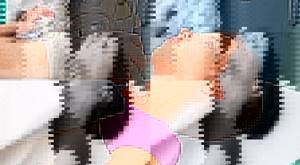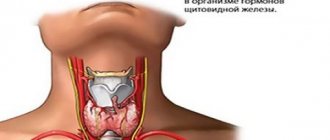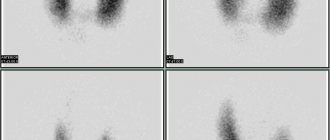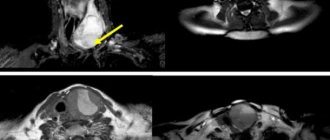Test
Read the following statements carefully and if you answer “true” add 1 point, “false” – 2 points, “don’t know” – 3 points.
- 1. The thyroid gland is a small organ located on the front surface of the neck in its lower part?
- 2. Does the thyroid gland produce hormones that are released into the blood and affect all cells and tissues in the body?
- 3. Do thyroid diseases affect people starting from childhood, or more precisely, already in the womb and throughout life?
- 4. Increased fatigue, weakness, weight gain, swelling of the face, dry skin, brittle nails and hair, constipation, memory loss - could these symptoms be manifestations of thyroid pathology?
- 5. Rapid heartbeat and interruptions in heart function, weight loss, feeling hot and heavy sweating, increased emotional lability - could these symptoms be manifestations of thyroid pathology?
- 6. Can pathology of the thyroid gland lead to heart damage?
- 7. Can pathology of the thyroid gland lead to menstrual dysfunction and infertility?
- 8. Is adequate intake of iodine in food important for normal functioning of the thyroid gland?
- 9. To replace iodine in the body, is it necessary to use iodized salt?
- 10. Is the need for iodine different at different periods of life?
- 11. Are some thyroid diseases hereditary?
- 12. Does the term “goiter” mean only an increase in the volume of the thyroid gland?
- 13. Can nodules appear in the thyroid gland?
- 14. To determine the structure of the thyroid gland, is it necessary to perform an ultrasound of the thyroid gland?
- 15. To clarify the function of the thyroid gland, is it necessary to examine the level of thyroid hormones in the blood serum?
- 16. With nodular and multinodular goiter, can the function of the thyroid gland be normal?
When you score from 0 to 20 points - you are well aware of the role of the thyroid gland in our body, from 20 and above - you need to carefully read the information below.
Operational disruptions
The level of thyroid-stimulating hormone produced by T3 and T4 is controlled by the pituitary gland. One of the common causes of dysfunction of the thyroid gland is the natural processes of aging of the body (reaching old age). Pathologies of other internal organs can also provoke defects in work. When the production of thyroid hormones decreases, hypothyroidism develops. With an increase in the synthesis of T3 and/or T4, hyperthyroidism, or thyrotoxicosis, is diagnosed.
In 80% of identified cases, the causes were:
- An increase in endemic goiter due to a lack of nutrients, primarily iodine.
- Attack of the thyroid gland by cells of its own immunity.
- Formation of thyrotoxic adenoma and other categories of tumors (both benign and malignant).
The thyroid gland and its role in the body
The thyroid gland is a small organ located on the front surface of the neck in the lower part, weighing 15-20 grams. The gland is so named because it is located in front of the thyroid cartilage of the larynx. It has two lobes connected by an isthmus.
The thyroid gland produces thyroid hormones - thyroxine and triiodothyronine, which, released into the blood, affect all cells and tissues of the body, regulate the speed of various metabolic processes. These hormones are responsible for many vital functions: they regulate the activity of the brain, the nervous and cardiovascular systems, the gastrointestinal tract, affect reproductive function, the functioning of the mammary and gonads, and much more.
What is the thyroid gland responsible for?
The thyroid gland is a kind of “storage” for iodine and several groups of important hormones. When blood outflows through the follicles, these substances enter the tissues of the internal organs. They also affect the receptors of various cells. As an example: thyroid hormones take part in metabolism; their reduced amount will greatly disrupt these processes. These same hormones have a regulating effect on:
- Speed and quality of metabolism.
- Normalization of appetite.
- Processes of sugar breakdown and absorption of its products by cells.
- Permeability of nutrients into the intestinal wall.
- The quality of the body's breakdown of fats.
- Cholesterol levels.
- Heartbeat and breathing rate.
- The body's absorption of oxygen.
- Heat-regulatory processes.
An insufficient amount of hormones in the mother's body during pregnancy can provoke incorrect or defective development of the fetal brain.
Thyroid enlargement
To determine the volume of the thyroid gland, ultrasound is used; normally, the volume of the gland should not exceed 18 ml in women and 25 ml in men. An enlarged thyroid gland or “goiter” can be a sign of various diseases of the thyroid gland, and can be accompanied by both a decrease and an increase in function. The most common is euthyroid goiter - an enlargement of the gland without disrupting its functions.
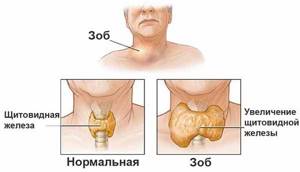
Treatment
It differs radically depending on the type of pathology. To treat hypothyroidism, replacement therapy is used: the patient is prescribed tablets with thyroid hormones.
The treatment of thyrotoxicosis is becoming increasingly more complicated. Because there are no direct antagonists of thyroid hormones. Therefore, the main attention is paid to the correction of symptoms from the cardiovascular system.
Patients with severe, malignant thyrotoxicosis are prescribed surgical treatment - resection of part of the gland or removal of the entire organ. After total removal, people are prescribed replacement therapy, as in the treatment of hypothyroidism.
Additionally, all patients are given recommendations on diet, physical activity, etc.
Endemic goiter
Endemic goiter is an enlargement of the thyroid gland that develops as a result of insufficient iodine intake in the body. Humans receive iodine through food and water. Iodine is an important component of thyroid hormones and is necessary for their normal functioning. If iodine intake is reduced, the thyroid gland compensatory increases in order to provide the body with enough hormones.
Iodine deficiency is most dangerous during the period of intensive growth of the child's body, during puberty, pregnancy and breastfeeding. The entire territory of Russia is an iodine-deficient region; in order to prevent the development of goiter, it is necessary to use iodized salt in the diet. Individual iodine prophylaxis involves taking iodine-containing medications.
The thyroid gland is located in the neck under the larynx. It distinguishes two lateral lobes and an isthmus connecting them, which is located at the level of 2-3 tracheal cartilages. The lateral lobes cover the trachea and are attached to it by connective tissue. The weight of the gland in an adult is on average 20-30 g. By the end of the first year of life, the gland weighs about 1 g, by puberty its weight reaches 14 g, and by the age of 20 - 30 g; in old age, the weight of the thyroid gland decreases slightly.
Structure of the thyroid gland
The thyroid gland is covered with two layers of connective tissue. The inner layer - the capsule of the thyroid gland - fuses with the parenchyma of the gland. Poorly defined partitions - trabeculae - extend from it into the thickness of the gland. The outer layer is a visceral layer of the internal fascia of the neck (fascia endocervicalis), which covers the larynx, trachea, thyroid gland, pharynx and esophagus. Between the capsule of the thyroid gland and the visceral layer there is a space filled with loose fiber in which arteries, veins, nerves and parathyroid glands are located.
The parenchyma of the thyroid gland consists of vesicles of different sizes - follicles, which are its structural and functional units (adenomers). The average size of a follicle is 40-50 microns. Each follicle is intertwined with a network of blood and lymphatic capillaries. In the lumen of the follicle, colloid accumulates - a secretory product of the epithelial cells that make up the lining of the follicle. The wall of the follicle is formed by one layer of thyrocytes lying on the basement membrane. The shape of the thyrocyte depends on its functional state.
Thyroid functions
The thyroid gland produces iodine-containing hormones - tetraiodothyronine (thyroxine, T4) and triiodothyronine (T3). These hormones stimulate oxidative processes in the cell, influence water, mineral, carbohydrate, fat, protein metabolism, growth processes, development and differentiation of tissues.
In the walls of the follicles, as well as between the follicles, there are cells that produce thyrocalcitonin, a hormone that is involved in the regulation of calcium and phosphorus metabolism. Thyroid calcitonin inhibits the resorption of calcium from bones and reduces calcium levels in the blood.
With hyperfunction of the thyroid gland (hyperthyroidism), more proteins, fats and carbohydrates are consumed - a person consumes more food, but at the same time loses weight. The body spends more energy, which contributes to rapid fatigue and exhaustion of the body. Hyperthyroidism leads to Graves' disease, which is accompanied by an enlarged thyroid gland, the appearance of a goiter, increased heart rate, irritability, sweating, and insomnia.
With reduced thyroid function (hypothyroidism), physical and mental development in children is inhibited, mental abilities are reduced, and sexual development is delayed. In adults, hypothyroidism is accompanied by myxedema, which causes fatigue, dry skin and brittle bones. The subcutaneous tissue swells, causing the face and other parts of the body to become puffy. Deficiency of thyroid hormones, especially at the age of 3-6 years, causes cretinism - delayed physical and mental development.
With a lack of iodine in food and water, the thyroid gland enlarges and endemic goiter develops. The thyroid gland tissue grows, but the production of hormones does not increase, since there is not enough iodine for their synthesis.
The activity of the thyroid gland increases during puberty. This is expressed in increased excitability of the nervous system. In the period of 21-30 years, a decrease in its activity is observed.
For any questions regarding thyroid pathology, please contact the Endocrinology Center in Krasnodar. We are located at: st. Festivalnaya, 3. Sign up by phone numbers indicated on the website.
Nodular goiter
Nodules called nodules may occur in the thyroid gland. One of the predisposing factors for their development is iodine deficiency in the body. With nodular or multinodular goiter, thyroid function can be normal, increased or decreased. “Thyroid nodule” is not yet a diagnosis; many thyroid diseases can manifest as nodular goiter. All patients who are found to have nodules in the thyroid gland that, according to ultrasound, exceed 1 cm in diameter, must undergo a puncture biopsy to determine the cellular composition of the nodule.
Diseases of the thyroid gland accompanied by dysfunction
Hypothyroidism
is an acute deficiency of thyroid function, a disease in which the thyroid gland cannot produce hormones in the required quantities, which leads to disruption and slowdown of metabolic processes in the body.
There are many different signs that may indicate hypothyroidism, these are: increased fatigue, weakness, swelling of the face, dry skin, weight gain, memory loss, constipation, chilliness. Hypothyroidism can be caused by many factors, the most common being chronic autoimmune thyroiditis (Hashimoto's goiter), a disease in which the gland is destroyed. Other causes of hypothyroidism include thyroid surgery and radioactive iodine treatment. Patients with insufficient thyroid function should receive replacement therapy.
The reverse process is also possible - hyperthyroidism - excessive activity of the thyroid gland in producing hormones. This may be a short-term reaction to physical stress or mental overload, or the process may be sustainable, in which case we are talking about thyrotoxicosis.
Thyrotoxicosis
- literally "thyroid hormone poisoning" - a condition caused by a persistent increase in thyroid hormone levels due to an overactive thyroid gland.
A person becomes irritable, tearful, restless, gets tired quickly, loses weight, despite a good appetite, he is worried about palpitations, interruptions in heart function, increased sweating, trembling in the hands or the whole body, the skin becomes moist and hot. The eyeballs often protrude, lacrimation and pain in the eyes begin.
The most common cause of thyrotoxicosis is diffuse toxic goiter (Graves' disease), an autoimmune disease that leads to an enlargement of the thyroid gland. Less commonly, the causes are nodular diseases of the thyroid gland (toxic adenoma, Plummer's disease) or its inflammation.
Symptoms of deficiency and excess of thyroid hormones
Hypothyroidism:
- Decreased heart rate - less than 60 beats/min.
- Deterioration of hair condition: brittleness, loss, dryness.
- Frequent feelings of chilliness.
- Increase in body weight, without changing diet.
- Variability of appetite: decrease or excessive increase.
- Deterioration of health: nausea, constipation, vomiting, weakness, dizziness.
- A sharp increase in cholesterol levels without changing diet.
- Changes in the menstrual cycle.
- Sudden changes in emotional state, frequent appearance of depression.
- Swelling of the face and limbs without increasing the amount of fluid consumed.
- Slowness of reaction, speech and thinking.
- Change in blood pressure.
- Swelling of the larynx, hoarseness in the voice, difficulty breathing.
- The appearance of sleep problems: insomnia, intermittent sleep.
Hyperthyroidism:
- Increased heart rate - more than 90 beats/min.
- Premature appearance of abundant gray hair and changes in hair structure.
- Increased sweating, inability to tolerate heat.
- A sharp decrease in body weight.
- Gastrointestinal disorders (diarrhea, vomiting).
- Feeling worse with increased light intensity (eye pain).
- Severe fatigue and muscle weakness.
- Trembling in limbs.
- Physical enlargement of the thyroid gland.
- Unreasonable increase in pressure.
- Dry mouth and thirst with frequent urination.
- In men, this can cause decreased potency, and in women, menstrual irregularities.
In some cases, hypothyroidism can cause the development of other serious diseases: kidney dysfunction, diabetes mellitus, disorders of the cardiovascular system and even obesity.
Diagnosis of thyroid diseases
Diagnosis of thyroid diseases is carried out by a doctor based on examination and history taking; to confirm and clarify the diagnosis, laboratory tests are prescribed (measurement of thyroid-stimulating hormone, assessment of the concentration of triiodothyronine, thyroxine, thyroglobulin content, absorption of radioactive iodine by the thyroid gland, various tests and antibody tests) as well as Ultrasound examination (ultrasound) of the thyroid gland, X-ray or computed tomography. If a tumor is suspected, a biopsy is performed.
If after reading this information you still have any questions, be sure to contact a specialist.
Remember that only a qualified endocrinologist can prescribe you the correct treatment, select the necessary medications and monitor their effectiveness.
Diagnostics
The primary diagnosis of the thyroid gland is palpation. The doctor prescribes an additional examination of the organ: tests for TSH, T4 and T3 levels, anti-TG and TPO, iodine levels. Additionally, the specialist prescribes an ultrasound examination and Doppler examination of blood flow. If any nodes, lumps or neoplasms are detected, a test will be carried out to determine the levels of calcitonin and thyroglobulin TG. This may also require a puncture along with a cytological examination of the cells of the compaction (neoplasm).
